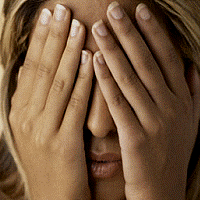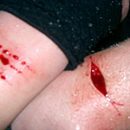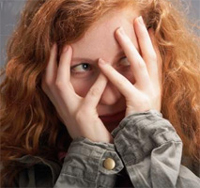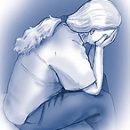Ill-known «delirium tremens» - nothing but one of the forms of alcohol psychosis. About the types of alcohol psychosis, about their symptoms and treatment you will learn from this article.
Content
Develop various psychosis, both sharp and chronic. Here
Description of the most characteristic and frequent forms of alcoholic
Psychosis.
 Alcoholic delirium (white hot) - the most common form of psychosis. Delia, as a rule, is developing suddenly, acutely, and not in a state of intoxication, but on the phonocrous abstineent syndrome, after 1-3 days after the cessation of drunkenness. This is usually preceded by filing (before the first psychosis - long). Quite often, delirium develops when entering the hospital (surgical, traumatologic, etc.), T.To. In these cases, the patient is forced to interrupt drunkenness on the circumstances independent.
Alcoholic delirium (white hot) - the most common form of psychosis. Delia, as a rule, is developing suddenly, acutely, and not in a state of intoxication, but on the phonocrous abstineent syndrome, after 1-3 days after the cessation of drunkenness. This is usually preceded by filing (before the first psychosis - long). Quite often, delirium develops when entering the hospital (surgical, traumatologic, etc.), T.To. In these cases, the patient is forced to interrupt drunkenness on the circumstances independent.
Sometimes the beginning of the Deliirium provoke various additional factors (operation, high temperature, injury, big blood loss). White hot can arise sharply, especially if any provoking hazards contribute to this, however, there may be harbingers. 2-3 days before the start of the disease, a dream is broken, which becomes superficial, anxious, with nightmarish dreams. The patient wakes up all in the sweat, anxiety. There may be short-term illusory deceptions of perception: it seems «alive» Figure on wallpaper, image in pictures and t.NS.
Psychosis itself is usually evolving in the evening. Growing anxiety, excitement. Deaths of perception, visual and auditory appear. The patient begins to see those who do not exist in reality objects and phenomena. Often see the clusters of small animals (mice, rats, cats), insects (flies, cockroaches, bugs), less often large animals «as in the zoo», devils (so they say - «Standed to hellikov»). Spectative deceptions (hallucinations) may be single, multiple or scene-like. Hearing deceptions of perception can join - «vote» People, devil. Since the patient is in a state of praised consciousness, hallucinatory images for it are of great relevance than the actual events. Therefore, all the behavior of the patient is determined by painful visions and «voices», not a real setting.
The patient sees mice and tries to save from them: hits them, screaming, climbs from them to bed, on the closet, runs away from the house. It does not distinguish real items from hallucinatory, so maybe, for example, in order to self-defense, attack the real police officer instead of seemingly. Due to the fact that the patient is not a passive contemplator of its fraudulent perceptions, but an active participant of all «events», it represents danger and for myself (maybe, «Saved», go out the window, jump from the height, commit suicide) and for others (kill «pursuer»). The patient is usually broken oriented in place (does not know where it is), time (what day, number), but the orientation is preserved in my own person (knows his name, the last name he, where he works, how old he is. D.).
Excitement reaches its climax at night. The day the state is improving, sometimes to complete «Enlightenment» and the appearance of criticism to transferred episode. This fact must also take into account patients, and medical personnel, T.To. The possibility of exacerbation of the state on the next night.
Name of psychosis «Delirium Trehens» It is due to the fact that patients have a peculiar overall tremor with hand shakes, an insecure unsustainable gait, an unintended handwriting, a vague speech. Along with mental violations, somatonevological: redness of the skin of the face, sharp sweating, heartbeat, blood pressure fluctuations, acute toxic hepatitis or cirrhosis, increase tendon reflexes. Sometimes in the period of psychosis there are convulsive epileptic seizures.
Delia usually lasts 3-5 days, even without treatment. With severe accompanying somatic disorders - up to 10 days. Recovery with abortive (short) delirium comes after a long sleep. In other cases, medical intervention is required. Currently, death is rare, although possible in case of a serious violation of cardiovascular activities, liver failure, brain edema.
The patient in a state of delirium should be immediately hospitalized. In the hospital appointed therapy aimed at relieving excitation, as well as to disintellation (cleansing the body from alcohol exchange products). Sometimes after a long sleep, the patient wakes up almost healthy. In case of severe somatic state, it is assigned tools for maintaining a cardiovascular system, liver, kidneys.
How to recognize alcoholic hallucinosis
Alcoholic hallucinia - second in frequency after delirium alcoholic psychosis. It is usually developing acutely or in a state of hangover syndrome, or in a period of long-suffering. The leaders in the clinical picture of the disease are hearing verbal (verbal) hallucinations, which arise with the clear consciousness and conservation of orientation in the surrounding. The patient first hears a simple noise, the knuckles of the wheels and then appear «vote», Taking the nature of the dialogue or even a whole meeting that condemns his behavior. The patient hears accusations and threats to their address, the conviction of his actions, drunkenness, the claims of punishment right up to the physical disgrace. Occasionally against the background of common struggle, swearing, threats appear timby lonely votes «Defenders». Patients under the influence of these votes are in a state of fear, anxiety, trying to escape from them, sometimes leaving far from home, turn to the police. Sugarless suicide attempts.
The disease can limit itself a few days, but more often continues weeks. Acute alcoholic hallucinia is inclined to recurrence (repetition) in the event of continued alcohol abuse. Approximately 1/4 of the patients he takes a protracted chronic course, continuing months and even years. In such cases, patients «Get used to» to their own «voices», There is a clear separation of them into two groups: the blants and protecting. Times of hallucinations subsided or stopped at all, the critical attitude to them appears, awareness of the disease. In some cases, chronic alcoholic hallucinosis is developing gradually, without a previous acute episode, as a rule, with long-term daily use of alcohol with chronic intoxication phenomena with subsequent development of dementia.
Hallucinations are stopped by the appointment of neuroleptic drugs. With a pronounced hangover syndrome - disinfecting therapy. It is also necessary to carry out anti-alcohol treatment, which, in turn, is prevention of alcoholic hallucinosis.
Types, symptoms and treatment of alcohol delusional psychosis
Depending on the content of delusional ideas, alcohol paranoid and alcohol deliberty are distinguished.
Alcohol Paranoid develops against the background of the abstineent syndrome or in a state of long-standing. There is a nonsense prosecution, which is a delusional (not appropriate reality) assessing the behavior of others. Separate phrases, gestures, facial expressions are of particular importance, as applied hints at the threat of their lives, massacre with them. Patients are alarming, confused, see the persecutors almost in every conversation. The behavior of patients determines the content of delusional ideas and is impulsive, t.E. can be expressed by sudden unpredictable actions (attack on imaginary enemies, flight, jumping from transport, from the window, suicidal attempts). Psychosis duration - from several days to several weeks. Signs of permanent consciousness, as a rule, are absent.
Brad of jealousy (married infidelity) arises mainly in men, after 40 years, long-abusant alcohol and having sexual problems (reduction of potency with elevated sexual activation). The development of the disease occurs gradually, in contrast to other psychosis. Initially, jealousy appears only in a state of intoxication or hangover and perceived by wives as an ordinary drunk brand. Only when suspicions in the marital infidelity become permanent, implausible, and the system of evidence - an alogistic, ridiculous, only then in the family begin to suspect the presence of a disease «jealous».
The subject of suspicion is most often a person from the nearest environment (neighbor, colleague, rarely - Son). The husband begins to follow his wife, check her underwear, search for an apartment in order to detect «evidence», confirming her treason. Any action of the wife is explained in troubled: it didn't immediately opened the door - hid the lover or waited when he leaves; She erases underwear - stains stains, went to the hairdresser - prepares for a meeting with her lover. Life with such patients is not only unbearable, but also dangerous. He can make any violent actions not only in relation to his wife, but also an imaginary lover. Sometimes such patients make extended suicides: kill his wife, «lover» and yourself. Significantly less often, nonsense of jealousy is in women suffering from alcoholism. If it develops, the consequences of it are no less dangerous than in men.
Treatment of such patients is possible only in stationary conditions, t.To. Critical attitude to its state is completely absent. Various neuroleptic agents are used and anti-alcohol treatment is carried out.
Korsakovsky psychosis, his symptoms and treatment
This disease first described with.WITH. Korsakov in 1877., By calling it with polynelectric psychosis due to the fact that along with gross mental disorders there are phenomena of polyneurite (damage to peripheral nerves) arise. Typically, the development of this disease is preceded by a heavy alcoholic delirium, to whose clinical picture is joined by gross disorders of memory. First of all, memory is violated on current events, t.E. Memory. Therefore, the patient cannot correctly call the date, the place of its location, disoriented in the environment, t.To. perceives everything as soon as seen and heard. He addresses his doctor every time as a stranger, repeatedly repeats the same requests. The patient does not remember that he ate for lunch, who came to him in the hospital, what he did during the day. Gaps in memory He replaces the events that happened to him earlier, or simply fiction and fantasies.
Events preceding the disease also fall out of memory. The duration of this period that fell out of memory may be different, from several months to several years. The logical thinking of patients is not disturbed, therefore rough disorders of the patients compensate for ingeniousness and guesses. Patients are partially aware of their illness and try to hide gaps in memory from others. Neurological disorders are manifested in polyneuritis of various degrees of severity: from the weakening of reflexes, skin sensitivity disorders to the complete absence of reflexes, muscle atrophy, rough gait violation.
Korsakovsky psychosis suffer both men and women. However, the latter are better amenable to therapeutic effects. Approximately half of patients as a result of treatment restores the ability to memorize and smoothed the symptoms of polyneurite. However, the forecast is more or less favorable only in cases of abstinence from drunkenness and long-term supporting therapy. The patients often forget that they were treated, and continue to drink.
Treatment complex. Massive disintellation and metabolic therapy are carried out, applying large doses of vitamins B1, B6, 12, C, nootropov. At the same time, massage, physiotherapy, physiotherapeutic procedures are prescribed for the treatment of polyneurite. Treatment is long-term depends on the severity of the disease and abstinence from alcoholization.









